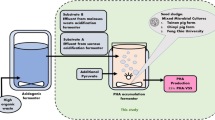Abstract
The work initially isolates and identifies the bacteria from pharmaceutical industrial wastewaters having amidase activity and then immobilizes and optimizes the reaction conditions adopting variants of batch, fed batch and continuous reactor system for maximum bioconversion of acetamide to acetohydroxamic acid. The maximum acyltransferase activity was obtained in 100 mM potassium phosphate buffer (pH 7.5) with substrate concentration 0.850 mmoles of acetamide and 1.7 mmoles of hydroxylamine hydrochloride with resting cells 0.94 mg (cell dry weight) (0.322 Uml-1) for 20 min at 55 °C. It had showed broad substrate specificity. Acetamide was the best substrate followed by acetonitrile. Industrial wastewater contains a large number of metal ions thus in view of future application of this research for real pharmaceutical wastewater treatment, the effect of a various metal ions on the immobilized cells was studied. Among the various metal ions and inhibitors, AgNO3 had only severely affected the enzyme activity. The short operation time of the proposed process, coupled with the possibility of an enzyme reuse during several cycles, are effective tools to implement this economically competitive semi-continuous reactor for amide biodegradation in pharmaceutical wastewaters.
Access provided by CONRICYT-eBooks. Download conference paper PDF
Similar content being viewed by others
Keywords
1 Introduction
Toxic nitrile and amides are extensively used in Pharmaceutical industrial operations due to which their occurrence in waste presents a major environmental and ecological hazard. Improperly handled and disposed industrial wastewaters imperil both human health and the environment. Among the nitrile degrading enzymes, amidases can play an important role in the detoxification of these compounds. This study makes use of microbial isolates with amidase acyl transferase activity in order to maximize the biodegradation of amides in industrial wastewaters. Moreover, it results in synthesis of pharmaceutically active hydroxamic acids, which have been reported as tumor inhibitors, anti-HIV, anti-malarial and anti-cancerous. Hydroxamic acids can also conjugate and eliminate containing metal ions and thus may be used for wastewater treatment and in nuclear technology. The work initially isolates and identifies the bacteria from pharmaceutical wastewaters having amidase activity and then immobilizes and optimizes the reaction conditions for maximum acyl transferse activity adopting variants of batch, fed batch and continuous reactor system.
2 Materials and Methods
In this work the effect of various substrates (aliphatic and aromatic amides) on acyl transferase activity of both immobilized cells was studied. However, further work involved acetamide as both immobilized cells exhibited good substrate affinity for it. Industrial wastewater contains a large number of metal ions thus in view of future application of this research for real pharmaceutical wastewater treatment, the effect of a various metal ions on both immobilized cells was studied.
Batch, fed-batch and semi-continuous operational modes were studied under laboratory conditions. The operational stability of acyltransferase was studied by preincubating immobilized resting cells of Bacillus in 0.1 M potassium phosphate buffer (pH 7.5) at 45 °C and 50 °C for 250 min. Enzymatic acetohydroxamic acid production kinetics under previously optimized conditions was investigated. The rate of conversion was higher in semi-continuous mode then fed and batch modes with Bacillus immobilized cells. Thereafter, a semi-continuous reactor for acetohydroxamic acid production was operated under the optimal conditions established in kinetic trials. Effect of substrate on ATA was studied by varying the concentration of acetamide and hydroxylamine-HCl.
A semi-continuous reactor was designed for acetohydroxamic acid production. The reactor vessel was glass with 3.0 L reaction volume. The reaction mixture was continuously recirculated through the column. The reactor was used to carry out successive reactions of acetohydroxamic acid production. For the startup, Beads ≈ 15 ml RC ≈ 50 mg dcw, 50.0 ml of 2 M acetamide 62.5 ml of 8 M hydroxylamine – HCl and 387.5 ml of 100 mM potassium phosphate buffer were added to the reactor. The total volume of mixture inside the reactor was 500 ml. Each reaction was carried out at 45 °C with agitation at 200 rpm over 2.0 h reaction time. Recirculation of the mixture through the column was continuous during the reaction. After each reaction the mixture was transferred to the settler to separate the products. The reaction cycles followed were repeated maintaining acetamide: hydroxylamine – HCl ratio as 1:5. Cells were separated from the reaction mixture by centrifugation at 10000 g for 10 min at 30 °C. Supernatant was freeze dried. The amount of acetohydroxamic acid formed was determined by using spectrophotometry and by HPLC and the kinetic parameters were calculated by means of a Line Weaver Burk Plot (or double reciprocal plot). The HPLC analysis showed the yield of acetohydroxamic acid was 96% (mol mol−1).
3 Results and Discussions
The enzyme of both immobilized cells efficiently hydrolyzed aliphatic amides in comparison to aromatic amides (Table 1). Propionamide was a very good substrate followed by butyramide, acetamide, and lactamide for Rhodococcus cells. Similarly, Acetamide was a very good substrate followed by Propionamide, butyramide, and acrylamide for Bacillus cells. It indicated that the amidase of both microorganisms is a broad-spectrum aliphatic amidase.
In the presence of AgNO3 (1 mM) 99% residual activity of amidase of Rhodococcus was recorded. However, at the same concentration of AgNO3 inhibition of amidase is seen in Bacillus cells (Table 2).
CuSO4.5H2O had inhibitory effect on enzyme of both cells. The metal ion chelators did not significantly altered the enzyme activity, which indicated either the complete absence of metal ions at the active site of enzyme or metal ions are tightly bound to the active site.
To get the optimum mole ratio of substrates (acetamide and hydroxylamine – HCl), the concentrations of acetamide was varied from 100 mM to 1000 mM at different hydroxylamine – HCl concentrations (200, 400, 600, 800, 1000, 1200, 1400, 1600, 1800 and 2000 mM) to determine the Km and Vmax of the immobilized amidase of Bacillus species. Initially acyltransferase activity of whole cells increased with an increase in acetamide concentration but just thereafter it remained constant or decreased with amide concentration for all hydroxylamine – HCl concentrations studied. The highest acyltransferase activity was obtained with 1000 mM hydroxylamine – HCl and 200 mM acetamide (Fig. 1 limited data shown for simplicity).
Acetohydroxamic acid production showed no inhibition by acetamide and hydroxylamine-HCl under the conditions used. Therefore, the reaction was described by a ping-pong mechanism and non-competitive inhibition by hydroxylamine. The kinetic parameters determined were: for acetamide (KmA 226 mM and Vmax = 71 µmol/min/mg dcw) and hydroxylamine HCl (KmB 995 mM and Vmax = 806 µmol/min/mg dcw) (Figs. 2 and 3). The enzyme acyltransferase had a lesser affinity towards the hydroxylamine as compared to acetamide due to higher Km value. In this semi-continuous reactor, immobilized enzymes were successively reused remaining in the reactor during all reaction cycles. Under these conditions, it was possible to maintain acetohydroxamic acid production yields of greater than 90% over four reaction cycles. Both the kinetic study and reactor operation showed Bacillus immobilized acyltransferase didn’t present any significant activity loss at high hydroxylamine concentrations.
4 Conclusions
The present study resulted in substantial acetohydroxamic acid production using whole cell biocatalyst in short time course. Similar process can be scaled up for bioremediation of various amides and the synthesis of other pharmaceutically relevant hydroxamic acid which finds wide application in different industries. Further, investigations regarding scale up of this integrated process with immobilized microorganisms for elimination of toxic amides and nitriles will be focusing towards recovery of resources so as to make wastewater management energy positive and financially viable.
Acknowledgments
We gratefully acknowledge the support of Jaipur Engineering College and Research Centre for providing necessary research facilities to carry out this investigation. The research for this paper was financially supported by Department of Science and Technology (DST), Government of India, vide their sanction no. 100/(IFD)/1899/2012-13.
Author information
Authors and Affiliations
Editor information
Editors and Affiliations
Rights and permissions
Copyright information
© 2017 Springer International Publishing AG
About this paper
Cite this paper
Sogani, M., Dongre, A., Sonu, K. (2017). Treatment of Industrial Wastewater Containing Amides Using Novel Bacterium in Semi-continuous Reactor. In: Mannina, G. (eds) Frontiers in Wastewater Treatment and Modelling. FICWTM 2017. Lecture Notes in Civil Engineering , vol 4. Springer, Cham. https://doi.org/10.1007/978-3-319-58421-8_57
Download citation
DOI: https://doi.org/10.1007/978-3-319-58421-8_57
Published:
Publisher Name: Springer, Cham
Print ISBN: 978-3-319-58420-1
Online ISBN: 978-3-319-58421-8
eBook Packages: EngineeringEngineering (R0)







